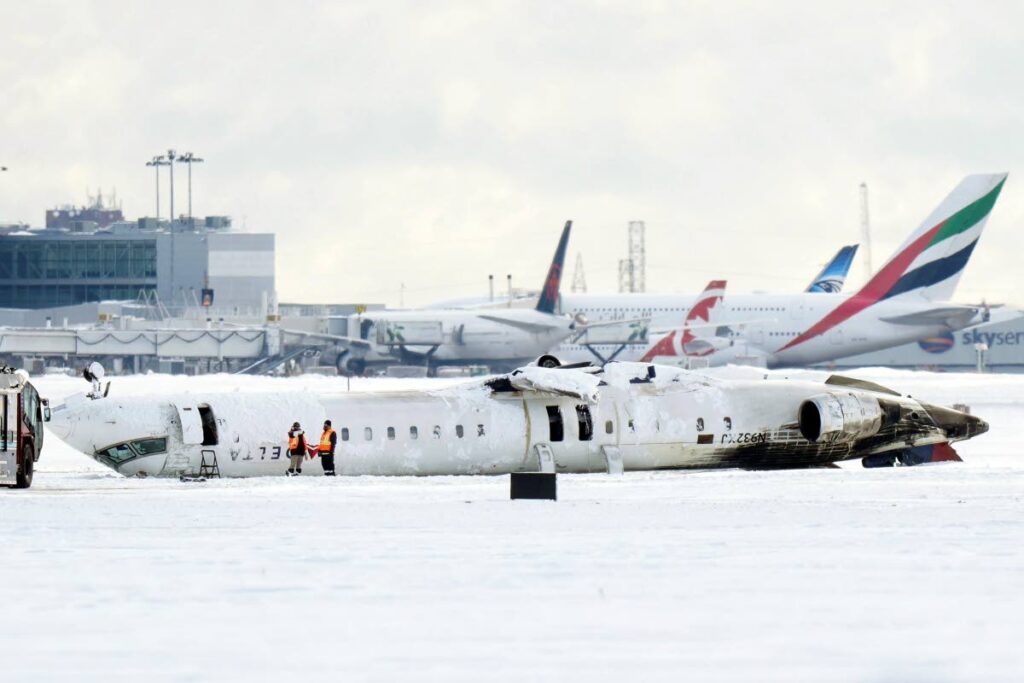Pathogens in the snow

Ramesh Lutchmedial
On March 10, 1989, a Fokker F28-1000 Fellowship twin jet operating Air Ontario Flight 1363 crashed shortly after takeoff from Dryden Regional Airport in Ontario, Canada.
The aircraft was unable to attain sufficient altitude to clear the trees beyond the runway, owing to a buildup of ice and snow on the wings.
Three of the four crew members, including both pilots, and 21 of the 65 passengers died.
The flight was under the command of Captain George Morwood, an experienced airman with 24,100 hours of flying time who had flown for approximately 34 years with Air Ontario. The first officer was Keith Mills, a highly experienced pilot with more than 10,000 hours' flying time and who had been with Air Ontario for ten years.
However, both pilots were new to the F28-1000, having flown fewer than 150 hours between them on the aircraft type.
The flight had departed from Thunder Bay, Ontario, bound for Winnipeg, Manitoba, with a stop in Dryden.
The Canadian Aviation Safety Board (CASB) immediately undertook an investigation into the crash, pursuant to the Canadian Aviation Safety Board Act.
The investigator in charge arrived at Dryden on March 11, 1989, with a team of 21 CASB investigators. The CASB team began its investigation as it would in any major accident investigation, interviewing witnesses and analysing the aircraft wreckage.
On March 29, 1989, under mounting public pressure, the investigation was suspended and the Canadian government appointed a royal commission to inquire into the contributing factors and causes of the crash, headed by Virgil P Moshansky, a former judge. The commission was authorised to make recommendations it deemed appropriate in the interests of aviation safety.
Immediate steps were taken to reactivate the investigation. The chairman of CASB was asked to second certain CASB aviation accident investigators to the commission to assist, and with the complete co-operation of CASB, the investigation was transferred to the Moshansky Commission.

Moshansky adopted a systems-analysis approach and delved deeply into the operations of Air Ontario, Transport Canada and the larger Canadian air transport industry.
This approach identified numerous safety-related deficiencies in the operations of Air Ontario and Transport Canada’s regulatory functions.
The post-crash fire severely damaged both the cockpit voice recorder and the flight data recorder, leaving both unreadable. So the investigative effort relied almost entirely on witness statements about the crash and the events leading up to it.
The investigation revealed an unserviceable auxiliary power unit (APU), and no available external power unit at Dryden Regional Airport, led to questionable decision-making – a critical factor leading to the crash. If the engines had been turned off, they could not have been restarted, owing to the unserviceability of the APU and lack of external power. So the left engine remained running during the stopover in Dryden.
Snow was falling gently that afternoon and 0.6-1.3 cm of snow had accumulated on the wings. They needed to be de-iced before takeoff, but the Fokker F28 aircraft is never supposed to be de-iced while engines are running, because of the risk of toxic fumes entering the cabin. The pilot, therefore, did not ask to have the wings de-iced.
Fuel needed to be loaded and was done with the engine running while passengers were on board. This is known as a hot refuelling. Off-loading and reloading the passengers would have taken considerable time, and the longer the aircraft stayed on the ground, the greater the need for the wings to be sprayed with de-icing fluid owing to snow buildup.
Moshansky’s report showed competitive pressures caused by commercial deregulation cut into safety standards, and that many of the industry's sloppy practices and questionable procedures put the pilot in a very difficult situation.
The report also said the aircraft should not have been scheduled to refuel at an airport that did not have proper equipment, and that neither training nor manuals had sufficiently warned the pilot of the dangers of ice on the wings.
Moshansky held Transport Canada responsible for letting Air Ontario expand its operations with larger and more complex aircraft without detecting the deficiencies in the operations of the existing aircraft fleet.
Another cause of the crash was the delay in implementing CASB recommendations for changes to de-icing procedures because of a dissenting report on the 1985 crash of an Arrow Air McDonnell Douglas DC-8 shortly after takeoff from Gander International Airport, Newfoundland. The aircraft crashed about half a mile from the runway owing to ice contamination on the wings' leading edges and upper surfaces, killing all 248 passengers and eight crew members on board. Four of the nine members of the CAB investigating team disagreed that ice buildup on the wings was the causal factor.
Both crashes undermined confidence in the CASB's investigations and led to the Canadian government's shutting down the CASB a year after the Flight 1363 accident. It was replaced by the Transportation Safety Board of Canada (TSB), a multimodal investigative agency.
After the crash of Air Ontario Flight 1363, many significant changes were made to Canadian aviation regulations, including new procedures on refuelling and de-icing, as well as many new regulations intended to improve the general safety of air transport. Specifically, these referred to the effectiveness of certain de-icing fluids over time and the increased use of Type II fluid. This mixture includes polymerising agents, which increases the effectiveness of the deicing.
In their book Beyond Aviation Human Factors, Maurino, Reason, Johnston and Lee wrote a chapter about Air Ontario Flight 1363 crash, Pathogens in the Snow.
Toronto crash 2025:
On February 17, a Delta Air Lines CRJ900 twin-jet aircraft on a flight from Minneapolis/St Paul International Airport crashed and turned upside down on the runway at Toronto Pearson International Airport while attempting to land during wintry conditions and with wind gusts up to 38 mph. All 80 people on board survived including the flight crew survived, but 18 were injured.
An US NTSB team is at the crash scene to assist the Canadian Transportation Safety Board with the crash investigation.

Comments
"Pathogens in the snow"